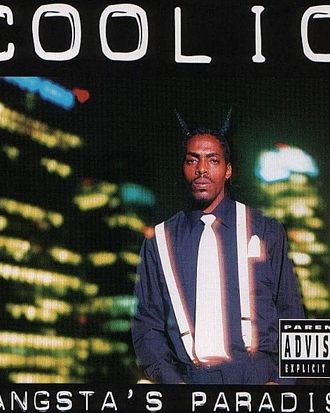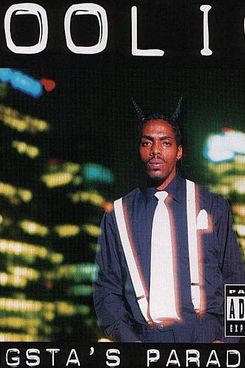

The Nostalgia Fact-Check is a recurring Vulture feature in which we revisit a seminal movie, TV show, or album that reflexively evinces an “Oh my God, that was the best ever!” response by a certain demographic, owing to it having been imprinted on them early. Now, years later, we will take a look at these classics in a more objective, unforgiving adult light: Are they really the best ever? How do they hold up now? We’ve already reconsidered Heathers, Ally McBeal, Ace of Base’s The Sign, Ghostbusters, Dinosaurs, and Adam Sandler. Our latest installment: Gangsta’s Paradise.
Background: Coolio, the Compton rapper born Artis Leon Ivey Jr., released his debut album, It Takes a Thief, in 1994, and quickly saw its single “Fantastic Voyage” become a sizable radio hit. The next year, though, Coolio dropped “Gangsta’s Paradise” — first via the soundtrack to Michelle Pfeiffer’s hero-teacher movie Dangerous Minds, then on his sophomore album, Gangsta’s Paradise — and cracked a whole new echelon. The song would become a massive success, topping charts worldwide and nabbing Coolio the Best Rap Solo Performance Grammy. Anchored by its title track and follow-up singles “Too Hot” and “1, 2, 3, 4 (Sumpin’ New),” Gangsta’s Paradise would sell over 2 million copies in the U.S. alone. It would be Coolio’s most accomplished moment: In the decade-plus since, the rapper’s relevancy and reputation have devolved mightily, cratering first in a 2009 Celebrity Big Brother appearance, then this purposefully misspelled Insane Clown Posse tattoo.
Nostalgia Demo: “Gangsta’s Paradise” was a rap song of the celebrated “crossover” variety, so most people who were listening to pop radio in the mid-nineties probably have something invested in this one. Also, presumably, at least a few Pfeiffer fanatics?
Nostalgia Fact-Check: First, some Coolio fun facts uncovered during the Fact-Check process: Pre-fame, he was both a firefighter and a crack addict for brief periods of time; also, his stage name originates from a run of talent-show performances as Coolio Iglesias.
On to the real talk. My most immediate memory of the subject matter is walking to my friend Louis’s house after school and having him call me a “foolio” (or telling me that people were calling me a “foolio” behind my back?) for liking Coolio. The problem, Louis explained, was that I self-identified as a rap fan but didn’t know about the real good stuff, like the Genius, a.k.a GZA from the Wu-Tang Clan. Appropriately, GZA’s universally acknowledged classic Liquid Swords was released only a few weeks before Gangsta’s Paradise. It’d be quite a few years, though, before I personally would hear it. And it’s safe to say I still haven’t listened to any particular track on Liquid Swords as many times as I’ve listened to “Gangsta’s Paradise.” Louis’s iconoclastic opinions aside, we all loved “Gangsta’s Paradise.” We paid money to see Dangerous Minds purely because of “Gangsta’s Paradise.” We knew (um, still know?) every single word to “Gangsta’s Paradise.”
That’s why I’m happy to report that hearing it again, after all these years — well, it was no small thing. It’s the third track on the album, following a standard the-hood-sure-is-messed-up-but-it’s-home-skit and “Geto Highlites,” which mines similar material over a fluffy groove. Then there’s a sudden, sharp transition, and those familiar dark snyths kick in, and, okay, maybe my heart jumped a bit. No one considers Coolio a reputable source on the corrosive nature of inner-city life anymore, but he’s striving to sound pained here — straining his voice, emphasizing the really messed-up bits — and he doesn’t totally miss. Just try not to root for the guy when he asks, “If they can’t understand it, how can they reach me?!” (Also, while he raps “I’m 23, but will I live to see 24?” on the track, Coolio was actually at the relatively advanced age of 32 at the time. Pure storyteller, that guy).
And all of a sudden, I had actual hopes for Gangsta’s Paradise. Coolio isn’t a particularly deft emcee, but at least on the title track, he’s solid and focused and rapping with conviction. Could he stay that engaging for the rest of the album? Nope! The screamingly nineties HIV-cautionary-tale “Too Hot” is up next, and it’s the kind of well-intentioned, yawningly simplistic material that makes you thank higher forces it’s 2011. There is actually a backup singer, faint in the background, attempting subliminal messaging: “listen to Coolio /the message comes from Coolio.” (Peep the video, though, for some groundbreaking people-disappearing CGI.) And it’s not the last time he dips full-force into cliché: Both “Smilin’,” a tribute to his kid, and “For My Sistas,” a female-empowerment ballad, are uninspired and execrable.
The greatest possible version of this album, at least as far as the Nostalgia Fact-Check is concerned, would have been as another product of the fertile nineties West Coast hip-hop scene. There were enough people at the time inspired by The Chronic and dropping cleanly enunciated rhymes over punchy, slow-ride G-Funk grooves that it’s not inconceivable Coolio could have turned out as one of them: not a modern-day punch line then, just a fondly if lightly remembered cult rapper. In this theoretical version, “Gangsta’s Paradise” doesn’t exist and Coolio gets to make tracks like the harder “Exercise Yo Game” — featuring E-40, the Bay Area rapper with a much more distinct delivery, whose lengthy, low-key career Coolio would be mimicking in this scenario — and “Kinda High, Kinda Drunk” all day long.
But that was never Coolio’s intention. One listen to “1,2,3,4” — a bouncy pop-rap number that can only be described as corny — makes that clear. “Gangsta’s Paradise” was a fluke, an anomaly. For the rest of the album, Coolio never again manages to channel that ominousness, instead spraying bullets in all directions: party rap, earnest declarations, unconvincing gun talk. And throughout, he never has much of anything to say.
This year, “Gangsta’s Paradise” made notable appearances in both The Green Hornet and Bad Teacher, with those movies callously playing to the warm feelings the track still engenders in the aforementioned demo (and, duh, me). Its presence is a joke. Does the song, taken only on its own merits, deserve better? Yeah, maybe. That it ended up where it did can be blamed both on its own massive early success, and on Coolio: He never did do enough to earn it a better fate.
There is one other thing the dude should get credit for, though. According to Wikipedia (and corroborated by the fact that we can’t think of anything to counter it), on “1,2,3,4” Coolio originated the “ain’t no party like a [blank] party cause a [blank] party don’t stop” construction. (In his case, it was a West Coast party). And for that, you should take a bow, sir. Like, a small one, though.

